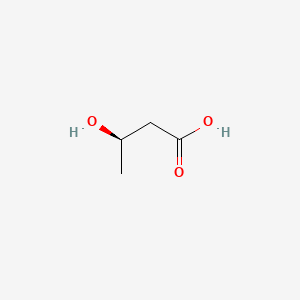| MeSH term | MeSH ID | Detail |
|---|---|---|
| Pregnancy Complications | D011248 | 19 associated lipids |
| Cat Diseases | D002371 | 12 associated lipids |
| Puerperal Disorders | D011644 | 4 associated lipids |
| Weight Loss | D015431 | 56 associated lipids |
| Critical Illness | D016638 | 13 associated lipids |
| Anorexia | D000855 | 8 associated lipids |
| Glucose Intolerance | D018149 | 13 associated lipids |
| Parkinson Disease, Secondary | D010302 | 17 associated lipids |
| Thinness | D013851 | 11 associated lipids |
| Neurodegenerative Diseases | D019636 | 32 associated lipids |
(r)-3-hydroxybutanoic acid
(r)-3-hydroxybutanoic acid is a lipid of Fatty Acyls (FA) class.
Cross Reference
There are no associated biomedical information in the current reference collection.
Current reference collection contains 2725 references associated with (r)-3-hydroxybutanoic acid in LipidPedia. Due to lack of full text of references or no associated biomedical terms are recognized in our current text-mining method, we cannot extract any biomedical terms related to diseases, pathways, locations, functions, genes, lipids, and animal models from the associated reference collection.
Users can download the reference list at the bottom of this page and read the reference manually to find out biomedical information.
Here are additional resources we collected from PubChem and MeSH for (r)-3-hydroxybutanoic acid
Possible diseases from mapped MeSH terms on references
We collected disease MeSH terms mapped to the references associated with (r)-3-hydroxybutanoic acid
PubChem Associated disorders and diseases
PubChem Biomolecular Interactions and Pathways
NCBI Entrez Crosslinks
All references with (r)-3-hydroxybutanoic acid
Download all related citations| Authors | Title | Published | Journal | PubMed Link |
|---|---|---|---|---|
| Jeukendrup AE et al. | Effect of medium-chain triacylglycerol and carbohydrate ingestion during exercise on substrate utilization and subsequent cycling performance. | 1998 | Am. J. Clin. Nutr. | pmid:9497182 |
| Binnert C et al. | Influence of human obesity on the metabolic fate of dietary long- and medium-chain triacylglycerols. | 1998 | Am. J. Clin. Nutr. | pmid:9537605 |
| Vazquez JA et al. | Protein metabolism during weight reduction with very-low-energy diets: evaluation of the independent effects of protein and carbohydrate on protein sparing. | 1995 | Am. J. Clin. Nutr. | pmid:7598072 |
| Musa-Veloso K et al. | Breath acetone is a reliable indicator of ketosis in adults consuming ketogenic meals. | 2002 | Am. J. Clin. Nutr. | pmid:12081817 |
| Hinderling VB et al. | The effect of etomoxir on 24-h substrate oxidation and satiety in humans. | 2002 | Am. J. Clin. Nutr. | pmid:12081827 |
| Kamphuis MM et al. | Diacylglycerols affect substrate oxidation and appetite in humans. | 2003 | Am. J. Clin. Nutr. | pmid:12716663 |
| Sevastianova K et al. | Genetic variation in PNPLA3 (adiponutrin) confers sensitivity to weight loss-induced decrease in liver fat in humans. | 2011 | Am. J. Clin. Nutr. | pmid:21525193 |
| Bortolotti M et al. | High protein intake reduces intrahepatocellular lipid deposition in humans. | 2009 | Am. J. Clin. Nutr. | pmid:19710199 |
| Vazquez JA et al. | Intravenously infused carnitine: influence on protein and branched-chain amino acid metabolism in starved and parenterally fed rats. | 1988 | Am. J. Clin. Nutr. | pmid:3137800 |
| Eckfeldt JH et al. | Error in calibration. | 1984 | Am. J. Clin. Pathol. | pmid:6695863 |
